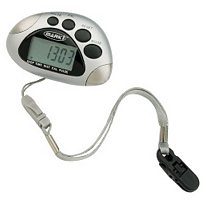 |
| Polar FT1 |
 |
| Timex Zone Trainer |
If you're not insisting on a chest strap/target zone training, there's a $20 finger contact one with pedometer included at Sam's Club in the vitamin/med/weight loss section. I didn't consider this an option, as if I just wanted a fingertip test while not running, I can use the wall mounted one at the track for free.
I expect to not use the HRM much after transitioning from run/walk to all running, but might use occasionally for pacing when trying to increase endurance.
I dowloaded a book sample on heart rate training and couldn't stand the author. He was making assumptions about me as an athelete that were not true, which led me to believe that buying the full book wouldn't benefit me much.
With no concrete training goals, I can adjust my HR target values based on preceved level of effort remembered after the workout. My goal is to increase duration and regularity of my workouts. If I need a day off after a workout, that's too hard.
Several formulas that give me MHR from 177-189 (turning 33 this month)
Helpful zone calculators

On Friday I did an HRM controlled run. My goal was to keep HR between 120 and 140 bpm. Commonly when I run my bpm is in the high forties, low fifties. I did my usual 4 laps, and was feeling strong, and decided to try for a max hrm reading sprint. I got my HR up to 179, then of course had to do another cool down lap, to match my record of 5 laps. Then I felt good enough to give the sprint another try, and took one more cool down lap for a new record of 6 laps. I felt good enough to try for 7, but decided that it would be unwise to do new speed work and new distance work in the same session, so I called it quits and went to the pool to relax my legs and work my arms...
ReplyDeleteI think the HRM was a worthwhile investment, although I do not use it for every run.
I find it interesting that some people that initially disagreed with my HRM purchase are now fans of Phil Maffeltone (philmaffetone.com) and his "The Big Book of Endurance Training and Racing" (http://www.amazon.com/gp/product/1616080655?ie=UTF8&tag=philmaffetone-20&linkCode=as2&camp=1789&creative=9325&creativeASIN=1616080655)
ReplyDeleteFrom reading his articles, the HR I've picked as my training pace is about equal to what he recommends for people my age recovering from severe illness. I've not yet seen any convincing evidence behind his formulas, but I think my method of adjusting training HR based on how I feel afterwards should work for everyone and produce similar results to the Maffletone method.